Jennie Goutet's Blog: A Lady in France, page 42
December 23, 2013
What Is Love?
The danger in writing passionately on the subject of tolerance is that you become intolerant of people who are not tolerant. And the danger in writing passionately about love - and how it is not self-seeking, proud, or boastful – is that you end up boasting about knowing and possessing the kind of love that doesn’t boast.
So let’s pretend that I am neither intolerant nor boastful, and say that I am merely passionate when I talk about my convictions regarding love, and what it is.
Most of you who read my blog know that I chose a rather fundamental Bible-based Christian path when I was 25 years old. I was raised in a moderate Christian milieu, so although somewhat different, my path was not completely foreign. But in the end it was the Bible that converted me – not people. It was the Bible that held for me an indisputable logic that caused me to become a little more “fanatical” than any of my entourage was probably comfortable with. They haven’t disowned me in these 18 years since, so there’s that, at least.
But if God had wanted puppets – clones who were identical in thought, reason, feeling and choice – he would have made puppets. He didn’t. This means that most of my life is spent adapting to people, and trying to understand feelings, choices, and a thought and reasoning process that I would not make. It hurts me to stretch my tolerance because some choices don’t naturally make sense to me. Sometimes I feel like I am physically pushing my mind and heart to understand another person who is wholly different from me.
But I do it because love is not self-seeking.
Our pastor and his wife know a family in the church back in Boston. Their daughter was highly allergic to peanuts. From an early age, they taught her to touch her tongue to foods outside of the home if there was any doubt whatsoever that there might be peanuts or peanut oil in it (even though they tried very hard to protect her everywhere they went). This was recommended to them, because any reaction from just touching her tongue to the food could save her from ingesting what was deadly to her.
But one time . . . just once, even touching her tongue to a food containing hidden peanuts was too much for her 8-year old body, and not even the swift action of her parents with the EpiPen could save her. Their young daughter died immediately.
I’ve been hearing a lot of frustration expressed by parents that don’t want an entire school to have to cater to one or two children who have food allergies. But how simple it is to show love to others by ensuring that the food you send with your child to their school won’t cause grief upon grief to the parents whose children have a severe allergy – who may die if they come into contact with even a small bit of it. What an easy sacrifice to make – we, whose children are fortunate enough to escape special considerations, such as a food allergy.
I am gluten-intolerant, and although I never expect people to make me gluten-free things, I am touched beyond words when they do. And when my friends bring their children over (who are highly allergic to eggs and dairy), I consider it a fun challenge to make a dessert that both they and I can eat – and to make one that doesn’t taste like cardboard.
I even like remembering the smaller details: Melanie takes 6 sugars in her coffee, Gerard has reactions to foods that have been frozen, Elizabeth is allergic to cinnamon. I like to remember people’s individual needs and desires as a way of showing them I care – that’s just me.
But children whose classmates need to be kept safe from certain foods, even if it means putting restrictions on school-wide celebrations, this should be a no-brainer and a willing act of solidarity for every parent as they choose to adhere to it.
Love always protects.

Back in New York, we were really close friends with a couple in our church. They were married a year before us, and had a child a year before us as well. After we moved to France, the husband decided that he no longer wanted to be in a heterosexual relationship, and – although he remained an amazing father to his son – he divorced his wife. This hurt. Oh this hurt - the end of a marriage we looked up to with people we loved. It hurt to witness the intense pain his wife suffered – she who was caught by surprise and unprepared to be abandoned.
Nevertheless, when our friend (the husband) brought his new boyfriend to Paris, we invited them over to dinner. Because, you see, we love our friends – both of them. And love keeps no record of wrongs (whether or not the wrong is against us – which, in this case, it wasn’t). We pulled out all the stops in hopes that they would feel welcome. I made leg of lamb and chocolate fondant. We had a cheese platter. We decorated the table. And we threw open our home and our arms to this couple.
Our friend was natural with us – he was unsurprised by our welcome. He knew us. His boyfriend was less comfortable. He was stiff and we couldn’t melt his frostiness with our warmth. I’m guessing it’s because he knew we were Christians, and he knew where our convictions lay, and I can’t say that I blame him for being wary. But we welcomed them because – although they follow their path and we follow ours – why should different paths preclude friendship?
Love always hopes. It always perseveres.
Apart from our lives in East Africa, where we were mainly surrounded by (and friends with) people of the Muslim faith, my first Muslim best friend was not until I met Amina in La Défense. Each of us has always remained staunch in our own convictions, but we tend to seek the common ground in our friendship rather than focus on the differences. She doesn’t try to teach my kids to adhere to her faith when they go over to play, and I respect her in the same way when her kids come over to our place.
(Except for the time right at the beginning when I accidentally gave her kids bacon crackers because I didn’t think to check – eeks! sorry!!)
But now that we’ve been friends for many years, I’m better prepared. I delight in making and serving Halal food for her family when they come over. Halal is the way of - sorry there’s no better way of saying this - butchering the animal with a special a prayer. I suspect it’s similar to Kosher food, and although none of my Jewish friends that live nearby are strictly Kosher, I would do the same thing for them.
Why should I cause my friends to stumble in their beliefs, or cause them to go against their consciences just because it’s not something required in my own faith? Accepting friends and allowing for their beliefs does not lessen my own convictions.
Love does not dishonour others.
Politically speaking, I am left-wing in America, and right-wing in France. The right is just too right for me in America, and the left is just too left for me in France. Of course the people I’m closest to in both France and America don’t perfectly agree with me. And it has nothing to do with their religious affiliation either. That surprised me at first. I honestly thought (living in New York) that all Christians would surely see how Christian-like the democratic party was. ha ha ha ha ha
It’s okay – you can laugh at me. And you can disagree with me. Many do.
But I will say this. There are educated and informed people choosing to subscribe to both ends of the political spectrum, and even to all the shades in between. I may not choose to agree with someone, but I will try to understand what drives them – why they make the decisions they make. What am I missing? What can I learn? Because surely you have something to teach me.
Love always trusts.
In the blend of experiences, thoughts, passion, convictions, environments that God allows each one of us to be subject to, there are bound to be different convictions and different choices that ensue.
There is so much to love that goes beyond “feelings.” It’s about respecting people’s needs, and allowing them the freedom to make their own choices, and granting them the space to express their own convictions.
I may have a long way to go in truly learning to apply this, but that’s what love is to me.
* * * * *
Love is patient, love is kind.
It does not envy, it does not boast, it is not proud.
It does not dishonor others, it is not self-seeking,
it is not easily angered, it keeps no record of wrongs.
Love does not delight in evil but rejoices with the truth.
It always protects, always trusts, always hopes, always perseveres.
Love never fails.
(1 Corinthians 13:4-8)
Image credit: yarruta / 123RF Banque d’images
The post What Is Love? appeared first on A Lady In France.
December 20, 2013
Frost
Dogs need to be walked. And that means you have to go outside, no matter what the weather is.
 But once you’re outside, you start to notice things.
But once you’re outside, you start to notice things.
 You notice how frost covers every green leaf
You notice how frost covers every green leaf
 and every brown.
and every brown.
 You notice how it covers every stick,
You notice how it covers every stick,
 every seed,
every seed,
 every pod ,
every pod ,

every berry,
 and every surface, including the wooden gate.
and every surface, including the wooden gate.
 You notice the sun rising quietly over the river,
You notice the sun rising quietly over the river,
 the reeds swaying imperceptibly,
the reeds swaying imperceptibly,
 the green-tinged tree trunks
the green-tinged tree trunks
 and the lovers’ claim to eternity.
and the lovers’ claim to eternity.
 You see the vegetables, dead and forgotten,
You see the vegetables, dead and forgotten,
 traces of autumn fading fast.
traces of autumn fading fast.
 You notice the winter skyline
You notice the winter skyline
 the river bank,
the river bank,
 the willows
the willows
 and the frozen dock.
and the frozen dock.

 Your dog needs to be walked every single darn day.
Your dog needs to be walked every single darn day.
 And so you notice things outdoors – just like you did when you were little.
And so you notice things outdoors – just like you did when you were little.
One point for the dog, I suppose.
* * *
I will be blogging over the holiday, but not on any set day or in any set category. I shall just write whatever and whenever strikes my fancy! Happy Holidays! 
The post Frost appeared first on A Lady In France.
December 19, 2013
Marché de Noel
Marché de Noel simply means “christmas market,” and the first word is pronounced “mahr-shay.” I was first introduced to the wonders of a European christmas market when I was visiting the Kirs Kringle Mart in Heidelberg oh, so many years ago. I tasted gluhwein (hot, spiced wine) and ate something delicious – probably breaded, fried meat – and I was hooked.
The Marché de Noel in Paris can hold its own next to the Kris Kringle Mart. Here are some of the stands you might see: Russian dolls with dour looking sales ladies at the stands.
 Provincial soap
Provincial soap
 and provincial lavender.
and provincial lavender.
 Touristy stuff.
Touristy stuff.
 And artisanal chocolates.
And artisanal chocolates.
 all made in France
all made in France
 I should not be creating this post on an empty stomach because it’s about to get real here. Know what else they have?
I should not be creating this post on an empty stomach because it’s about to get real here. Know what else they have?
Chestnuts roasting on an open fire!
 Jack Frost nipping at . . . (oh wait)
Jack Frost nipping at . . . (oh wait)
And gluhwein of its own, called vin chaud.
 (I bought a kit to make it with alcohol-free wine and it turned out well.
(I bought a kit to make it with alcohol-free wine and it turned out well.
Cotton candy, translated as “daddy’s beard.”
 Crèpes and waffles!
Crèpes and waffles!
 And soups and beer!
And soups and beer!
 And sweet fried treats!
And sweet fried treats!
 And . . . a chance to toss it all on the amusement rides!
And . . . a chance to toss it all on the amusement rides!
 (There’s a good reason I’m on that ride with the kids, and not Matthieu. I only toss my cookies when pregnant).
(There’s a good reason I’m on that ride with the kids, and not Matthieu. I only toss my cookies when pregnant).
 And the Marché de Noel is no less enchanting at night -
And the Marché de Noel is no less enchanting at night -
 where you can continue to shop
where you can continue to shop
 and continue to eat.
and continue to eat.
 And eat.
And eat.
 And eat.
And eat.
 If the sights and smells and tastes don’t strike you as simply enchanting . . .
If the sights and smells and tastes don’t strike you as simply enchanting . . .
 have some more gluhwein!
have some more gluhwein!
 (kidding, kidding)
(kidding, kidding)
The post Marché de Noel appeared first on A Lady In France.
December 17, 2013
Foie Gras Pops
Oh yes she did! Move over Bakerella (wid’ yo bad self and your highly addictive cake pops).
Hel-lo foie gras pops!
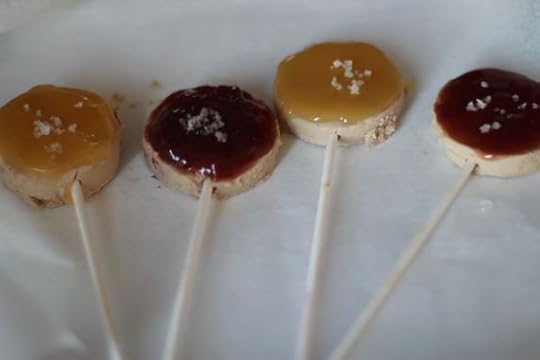 What? Did you say something?
What? Did you say something?
Foie gras is pronounced “fwah-grah” and it literally means fatted liver. But just forget I said that.
It’s usually made from duck liver, although the more authentic foie gras is made from goose. I won’t gross you out with how it’s made; I’ll only tell you that it’s usually eaten with large grain sea salt, onion confit, or fig jam – but not all three together. My favourite is fig jam, so it wasn’t a huge stretch for me to try out some other jams to give the pops some more colour.
For these tasty treats, you will need foie gras
 gelatin sheets and lollipop sticks
gelatin sheets and lollipop sticks
 an assortment of jam . . .
an assortment of jam . . .
 and a sense of the ridiculous.
and a sense of the ridiculous.
Cut the foie gras – not too thick.
 And then use a small glass to cut perfect circles.
And then use a small glass to cut perfect circles.
 Gently slide the lollipop stick in the centre of the foie gras. (It’s like trying to find a vein with a large needle. You may need to push down on the foie gras to keep a fissure from forming in the centre).
Gently slide the lollipop stick in the centre of the foie gras. (It’s like trying to find a vein with a large needle. You may need to push down on the foie gras to keep a fissure from forming in the centre).

You can smooth over any imperfections with your finger – like you can with clay!
 Now take your various jams. I made the glaze by soaking sheets of gelatine in cold water.
Now take your various jams. I made the glaze by soaking sheets of gelatine in cold water.
 I cut it into two to fit – not sure if you can see it in there. It’s one sheet per glaze.
I cut it into two to fit – not sure if you can see it in there. It’s one sheet per glaze.
 And I took three tablespoons of the jam and microwaved it for 30 seconds.
And I took three tablespoons of the jam and microwaved it for 30 seconds.
 Then I added a tablespoon of hot water.
Then I added a tablespoon of hot water.
 Now, switching over to the red glaze – I made 4 -
Now, switching over to the red glaze – I made 4 -
 I added the gelatine sheet.
I added the gelatine sheet.
 I strained it whenever I could. The strawberry was hard to strain
I strained it whenever I could. The strawberry was hard to strain
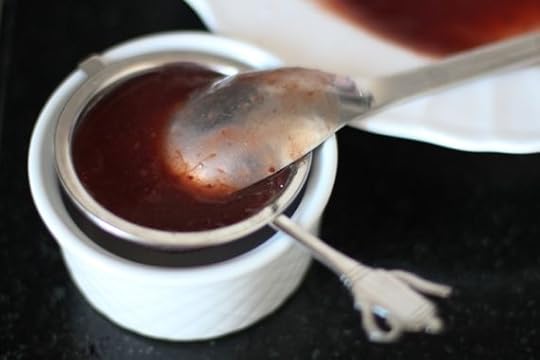 but the blueberry was super easy.
but the blueberry was super easy.
 I ended up using another sheet of gelatine for the blueberry since it was too runny. But if you do that, give it some time to set or your pop will end up looking like this:
I ended up using another sheet of gelatine for the blueberry since it was too runny. But if you do that, give it some time to set or your pop will end up looking like this:
 Spoon, then lightly spread the glaze over the foiegraspops
Spoon, then lightly spread the glaze over the foiegraspops
 Sprinkle a couple grains of sea salt . . .
Sprinkle a couple grains of sea salt . . .
 and tie ribbons for decoration.
and tie ribbons for decoration.
Actually, a word to the wise. You would do better to tie the ribbons on the lollipop sticks before you even insert them in the foie gras. They were difficult to tie after the fact and they got soaked in the glaze.
Serve your foie gras as an appetiser, with 3-4 toasts cut to size.
 And when you eat the foie gras, don’t spread it on your toast. You’re supposed to cut a small piece and place it on top of the toast, then pop the whole thing in your mouth. Like eating sushi!
And when you eat the foie gras, don’t spread it on your toast. You’re supposed to cut a small piece and place it on top of the toast, then pop the whole thing in your mouth. Like eating sushi!
You’ll need some champagne, of course -
 even if it’s alcohol-free like ours.
even if it’s alcohol-free like ours.
And then you’re all set for your holiday meal! 
* * *
(In full disclosure, the idea for making sucette de foie gras came from a page torn from some culinary magazine a friend lent me. The rest are my own ideas).
The post Foie Gras Pops appeared first on A Lady In France.
December 16, 2013
Thankful
This past weekend we had one of those rich, full weekends, where all the events put together made everything seem larger than life. Do you know the kind of weekend I’m talking about?
As most of you know, my memoir was published on Amazon.com on Friday. And seriously, I got such an encouraging and enthusiastic response from all of you, I just felt covered in blessings. I spent most of the day thanking people on twitter and Facebook for all of the support.
This book was twenty years in the living, and two years in the writing, so it was no small accomplishment for me.
On Saturday, I had my English classes in the home, and since it was the last class before the holidays, we made Christmas cookies together. Cookie decorating is fun in any language and my students appreciated the break from grammar.
And in the afternoon, we hosted a holiday tea with neighbors, whose children are the same age as ours.
 It was the perfect excuse to decorate the table in holiday cheer,
It was the perfect excuse to decorate the table in holiday cheer,

and light candles

and set out delicious things to eat.
 As I was in the process of setting everything out, the doorbell rang, which provided just enough distraction for Hunter to run into the kitchen and scarf a line of Russian tea cakes. As I dragged him outside by the collar, I saw a gentleman standing on the other side of the gate, smoking a cigarette and waiting nervously as I got a hold of our dog.
As I was in the process of setting everything out, the doorbell rang, which provided just enough distraction for Hunter to run into the kitchen and scarf a line of Russian tea cakes. As I dragged him outside by the collar, I saw a gentleman standing on the other side of the gate, smoking a cigarette and waiting nervously as I got a hold of our dog.
When he finally had my attention, he started speaking softly and I just managed to catch something about donations and P.O. boxes and homeless people.
“Wait,” I said. “You mean you’re collecting donations to help people without a home to get a P.O. box so they have a chance at getting a job?”
“Yes,” he replied. “So they have some hope of getting out of their situation.”
“Oh I definitely want to support that,” I answered. “Wait right here please.”
As he was filling out the tax receipt for my donation, he thanked me earnestly. And I responded, “It’s the least I can do! I mean I have a home and everything. How could I not give?”
He relaxed visibly and even smiled, as he answered, “It’s just nice to have a warm welcome. I don’t always have that.”
After he was gone, something tugged at my heart. I was sad that he wasn’t well-received wherever he went, and I was sad I couldn’t do more. I was also conscious of how grateful I was to have a cozy, welcoming home for my own family – one that I could open for friends. I urgently wished for his situation to improve so that he could have that too.
I didn’t have much time to reflect on all of these things, however, because our friends arrived with winter coats, noise and laughter.
They were carrying two things: a bouquet of flowers -
 and an electric, remote-controlled car that was as much for the dads as it was for the kids.
and an electric, remote-controlled car that was as much for the dads as it was for the kids.

My seven-year old son was taking care of something indoors, and he was the last person to race out of the house to see the car. Everyone was standing on the opposite side of our quiet street – standing on the sidewalk because a car was about to pass.
But my son raced towards the gate with absolutely nothing on his mind other than the need to hurry and not miss out on the electric car. My husband saw his focused attention before he even reached the gate, and started yelling, “Gabriel! Gabriel! GABRIEL!!! STOP!!!!!!”
Gabriel didn’t hear him because he was so intent on joining the crowd on the other side of the street. He let the gate slam behind him and started to race into the road, hidden from the oncoming driver’s view by a large white van that was parked next to our house.
The driver was going rather fast for our quiet street, and although she couldn’t see Gabriel, perhaps she sensed something was amiss from the fact that my husband was yelling. She slammed on her brakes . . . coming to a screeching halt no more than six inches from my son.
So we were spared grief upon grief, and sorrow upon sorrow on Saturday. And our emotional weekend of gratitude for personal triumph, and gratitude for material blessings had one more added to it – that of the oppressive gratitude expressing itself in trembling relief over an outcome that could have happened . . . but didn’t.
 It strikes me that in this holiday season – as in every day – there is always something to be grateful for.
It strikes me that in this holiday season – as in every day – there is always something to be grateful for.
* * *
Rejoice always,
pray continually,
give thanks in all circumstances;
for this is God’s will for you in Christ Jesus.
1 Thessalonians 5:16-18
The post Thankful appeared first on A Lady In France.
December 12, 2013
My Memoir is Out on Amazon!
My book is published! I wrote a whole book!
And this is the second-most exciting thing I’ve ever done after having children. It’s even more exciting than traveling the world!
Here’s my friend Greta, together with her adorable daughter, getting my book in the mail. She was kind enough to offer to do a book review for me. (She blogs at G*Funk*ified). And Greta got her copy before anyone else, including me!
Since I’m still waiting for mine to arrive, it was nice to see it in photo form, especially blessed by those grins.

You might have read the book as a series on my blog, starting last January. I’ve since removed it – or at least, I’m working on removing it. But even if you’ve already read it, I’ve made changes based on the suggestions of a professional editor. Hopefully this will bring the story to life by making it more coherent .
This is what the back cover says:
At seventeen, Jennie Goutet has a dream that she will one day marry a French man and sets off to Avignon in search of him. Though her dream eludes her, she lives boldly—teaching in Asia, studying in Paris, working and traveling for an advertising firm in New York.
When God calls her, she answers reluctantly, and must first come to grips with crippling loss, depression, and addiction before being restored. Serendipity takes her by the hand and she marries her French husband, works with him in a humanitarian effort in East Africa, before settling down in France and building a family.
Told with honesty and strength, A Lady in France is a brave heart-stopping story of love, grief, faith, depression, sunshine piercing the gray clouds—and hope that stays in your heart long after it’s finished.
And this is from three of my published friends who were sweet enough to give me a review:
“Jennie Goutet weaves her tale with passion, humor and heart-wrenching honesty—sometimes so raw you have to look away, but then you can’t wait to look back.” Shari Simpson, comedy writer for Nickelodeon
“In this beautiful memoir, Jennie Goutet details the evolution of one woman’s faith and love in a singular story that is—at once—both intensely personal and universal in its themes. I soared and plunged along with her from beginning to end.” Julie C. Gardner, co-author of You Have Lipstick on Your Teeth
“Jennie’s honest and touching words drew me in from the very first page. A must read!” Kerstin Auer, author of The immigrant’s ABC
You can buy my memoir by clicking on the book cover here:

which leads you to amazon.com, or by going to the amazon website in your country and typing “A Lady in France” in the book section.
And if you like it, will you kindly spread the word on Facebook and leave me a review on Amazon or GoodReads? Without a highly paid publicist, the only way for people to even know the book exists is through word of mouth.
Thank you!

The post My Memoir is Out on Amazon! appeared first on A Lady In France.
Champs Elysées at Christmas
Would you like to know how to pronounce the “Champs Elysées?” For the first word, you say the name “Shawn.” But right before you’re about to touch your tongue to the roof of your mouth to make the “n” sound, you swap it out with a “z” instead. Still with me? So it’s like this – shaw(n)z – ay-lee-zay.
It’s been around since 1670 as a grand avenue leading up to the king’s palace (which is now the Louvre). But back then it was planted with trees, wheat and oats. And now . . . 
Now it’s a tad more commercial. The Champs Elysées is one of my favourite places in Paris. For one thing, it’s very cheerful, with all the stores and restaurants and people. And you don’t notice the crowds because the avenue is so wide. Plus – it’s easy to get to.
But at Christmas!
 Oh, at Christmas -
Oh, at Christmas -
 and especially Christmas at night . . .
and especially Christmas at night . . .
 everything comes to life.
everything comes to life.

Lights everywhere.

 Lights – and trees!
Lights – and trees!


 Let’s take the avenue in one sweep. This is looking towards the Place de la Concorde.
Let’s take the avenue in one sweep. This is looking towards the Place de la Concorde.

The Louvre is just beyond that.
And here is looking in the opposite directions towards the Arc de Triomphe.
Here’s the Arc closer up.
Paris is magical at all times.
 But even more so at Christmas-time!
But even more so at Christmas-time!
 Next week! The Marché de Noel
Next week! The Marché de Noel
The post Champs Elysées at Christmas appeared first on A Lady In France.
December 10, 2013
Step-by-Step Instructions for Making an Opéra
So. The pâtisserie called “Opéra,” pronounced oh-pair-ah. Do you know it? This post gives you step-by-step instructions with photos for how to make one. There are 44 photos in all. One of them is this.
 It’s not for the faint of heart.
It’s not for the faint of heart.
You will need to make the following things: cake layer, the coffee syrup, italian merengue (which is part of the buttercream), the buttercream, the chocolate ganache, and the chocolate glaze. That’s six things dude! But I’m here to walk you through it. And also to give you tips for making a more successful version than mine. Although mine was super delicious, its appearance left something to be desired. Have no fear. You will do me one better.
Here are the materials you will need: baking sheets (ideally 3), candy thermometer, metal spatula, a beater (ideally a handheld plus a KitchenAid equivalent), wax paper, your own personal dishwasher. It’s also a good idea to make the cake part the night before, and the other ingredients – plus assembly – the morning of. That way it has an entire day to sit in the refrigerator.
Alright, let’s start with the cake. The biscuit layer. This recipe comes from a pastry chef named Christophe Felder and his book called Leçons de Pâtisserie. This also has photos and step-by-step instructions, but a lot of it is not self-explanatory, as it’s not written for dummies like me. Plus it’s in French. So I figure I’d save you the translation and confusion.
Okay back to the cake, which is Step One. Preheat the oven to 400°F and put wax paper on 3 baking sheets.
Put a cup of eggs (yeah. seriously – that’s 220 grams. they weigh stuff over here,) plus 5 large egg yolks, plus 2.5 cups of ground almonds and just under a cup of sugar – put all that in the mixing bowl and mix for 15 minutes. (You see why a handheld mixer is not quite enough? I borrowed a standing mixer for this recipe).
 When there are a couple of minutes remaining, mix 3 large egg whites plus 1/2 cup sugar until it has formed stiff peaks.
When there are a couple of minutes remaining, mix 3 large egg whites plus 1/2 cup sugar until it has formed stiff peaks.
 Fold the egg whites into the rest of the mixture
Fold the egg whites into the rest of the mixture
 Then and add a cup of flour and mix again. Don’t beat it, but mix until you don’t see any more streaks of flour and egg whites. By the way, I used gluten-free flour because I have celiac disease and can’t go out and buy my own opéra cake, even though I live in France. This recipe works really well with a GF flour mix.
Then and add a cup of flour and mix again. Don’t beat it, but mix until you don’t see any more streaks of flour and egg whites. By the way, I used gluten-free flour because I have celiac disease and can’t go out and buy my own opéra cake, even though I live in France. This recipe works really well with a GF flour mix.
 Pour the batter equally on to the three baking sheets, lined with wax paper.
Pour the batter equally on to the three baking sheets, lined with wax paper.
 and use the metal spatula to spread it over the entire thing.
and use the metal spatula to spread it over the entire thing.
 Bake each sheet for about 10 minutes – but do check on them. These things can bake quickly. I ended up turning the heat down and baking them for less time because my oven is very hot.
Bake each sheet for about 10 minutes – but do check on them. These things can bake quickly. I ended up turning the heat down and baking them for less time because my oven is very hot.
 Here they are!
Here they are!
If you’re really making them the night before – which is a good idea – cover them in plastic (with wax paper in between each layer) and put them in the refrigerator.

And one out of the six steps is finished! Congratulations! Now go get some sleep. Oh! And set out some butter so it’s really soft for the next day.
Next day, and moving right along. Prepare the coffee syrup. This is Step Two. I don’t know why he calls it syrup because it’s still quite liquid-y. But it’s not something you’d want to drink either because it’s super sweet. Mix 1 3/4 cups of coffee (from your machine) with 3/4 cup sugar and 3 additional tablespoons of strong instant coffee.
 And there’s your syrup. I made the mistake of soaking the cake part with the syrup before putting it in the fridge, but that was a mistake. The cake became soggy and didn’t always hold together when I assembled it.
And there’s your syrup. I made the mistake of soaking the cake part with the syrup before putting it in the fridge, but that was a mistake. The cake became soggy and didn’t always hold together when I assembled it.
Brush the coffee syrup on generously until you’ve used all of it on the three cakes. But do it the next day right as you’re in the process of assembling. There’s a lot of liquid, but an Opéra is supposed to be quite coffee flavoured – and quite brown – so go to town in brushing/pouring on the syrup. I didn’t use all of mine and my cake layers ended up being too “white.”
 Two out of six steps are done. Now it’s time to make the coffee buttercream. In French it’s called crème au beurre légère. But the insane thing is that in order to make that, you first have to make the Italian merengue. So let’s do that.
Two out of six steps are done. Now it’s time to make the coffee buttercream. In French it’s called crème au beurre légère. But the insane thing is that in order to make that, you first have to make the Italian merengue. So let’s do that.
Step Three. The meringue italienne. In a saucepan, heat up 3 tablespoons of water with 1/2 cup of sugar. Use a candy thermometer to measure the temperature.
 When it gets up to 114° C, start beating your egg whites (2 large egg whites) with your sugar (just under 1/4 cup).
When it gets up to 114° C, start beating your egg whites (2 large egg whites) with your sugar (just under 1/4 cup).
At 118°C precisely, take the sugar water (which is now syrup) off the heat and start pouring it into the egg whites as you mix.
 Beautiful huh? Set it aside.
Beautiful huh? Set it aside.
 Step Four. Now we have everything we need to make the coffee buttercream. You’ve put the merengue in a different bowl. Now put 5 large egg yolks in the standing mixer bowl and give it a quick whirl. And you have to repeat the sugar-water-syrup-making step. Except this time there is much more of it, which means it takes longer to form a syrup. Combine 1 cup plus 1 tablespoon sugar with 1/2 cup minus 1 tablespoon of water.
Step Four. Now we have everything we need to make the coffee buttercream. You’ve put the merengue in a different bowl. Now put 5 large egg yolks in the standing mixer bowl and give it a quick whirl. And you have to repeat the sugar-water-syrup-making step. Except this time there is much more of it, which means it takes longer to form a syrup. Combine 1 cup plus 1 tablespoon sugar with 1/2 cup minus 1 tablespoon of water.
Since the French weigh everything, the measures are a little wonky. But I hate weighing stuff, which is why I’ve converted everything to cups and spoons for your baking pleasure.
 I didn’t wait long enough when I made the sugar-water-syrup this time around. The thermometer seemed to stay stuck at 102°C so I thought it was broken. But then when I poured it over the yolks, it was way more liquid-y than the first time around. I was a little worried I had botched it. (So yes – you need to do the same thing as in the merengue – pour the hot syrup over the yolks as the mixer is running).
I didn’t wait long enough when I made the sugar-water-syrup this time around. The thermometer seemed to stay stuck at 102°C so I thought it was broken. But then when I poured it over the yolks, it was way more liquid-y than the first time around. I was a little worried I had botched it. (So yes – you need to do the same thing as in the merengue – pour the hot syrup over the yolks as the mixer is running).
 But when I spooned the yolk-syrup mixture, it looked pretty similar to the picture I saw in Mr. Felder’s book. It was only a tiny bit runnier, and the buttercream turned out perfectly in spite of it. So it wasn’t the end of the world.
But when I spooned the yolk-syrup mixture, it looked pretty similar to the picture I saw in Mr. Felder’s book. It was only a tiny bit runnier, and the buttercream turned out perfectly in spite of it. So it wasn’t the end of the world.
 Here’s where a handheld comes in handy. You’ll need to beat very soft butter on the side – 2 cups’ worth.
Here’s where a handheld comes in handy. You’ll need to beat very soft butter on the side – 2 cups’ worth.
 Then add it to the yolk-syrup mixture.
Then add it to the yolk-syrup mixture.
 And then the merengue. You forgot about it, didn’t you? The meringue italienne? Time to add it now and mix it all together, giving a delightful airy consistency and lightly sweet taste.
And then the merengue. You forgot about it, didn’t you? The meringue italienne? Time to add it now and mix it all together, giving a delightful airy consistency and lightly sweet taste.
 Since the buttercream is coffee-flavored, you’ll need to add a half-espresso, plus 3 tablespoons instant coffee (preferably expresso powder since it will be finer and mix in more smoothly).
Since the buttercream is coffee-flavored, you’ll need to add a half-espresso, plus 3 tablespoons instant coffee (preferably expresso powder since it will be finer and mix in more smoothly).
 Pour the coffee and instant powder into the cream.
Pour the coffee and instant powder into the cream.
 Then mix well and set aside.
Then mix well and set aside.
Step Five. We need a chocolate ganache, because that’s one of the layers in an opéra. Chop up 170 grams of good dark chocolate. I’m pretty sure I used 70%, which is bittersweet.
 Heat up 1/3 cup cream plus 1/2 cup milk. Skim off the yucky stuff.
Heat up 1/3 cup cream plus 1/2 cup milk. Skim off the yucky stuff.
 Pour it over the chocolate bits and stir until it’s all melted.
Pour it over the chocolate bits and stir until it’s all melted.
 Mix in 20 grams of butter and ganache is done.
Mix in 20 grams of butter and ganache is done.
Step Six. Actually, you can do this step when the entire pâtisserie is assembled and has been refrigerated for an hour. But let’s give the instructions now – it’s for the chocolate glaze on top. Melt 400 grams of sweet dark chocolate (52%), 50 grams of margarine and 50 grams of peanut oil.
 And here is the other area where I botched it. I microwaved the chocolate too long and it became thick. A glaze is supposed to be runny, but mine was not.
And here is the other area where I botched it. I microwaved the chocolate too long and it became thick. A glaze is supposed to be runny, but mine was not.
 I added a little more oil and kept stirring, but it was not the thin glaze I needed and I had no time to run out and get more because I was serving the opéra that same evening. The chocolate was as thick as all the other layers when I spread it on, and it had hardened so that it was top-heavy and not easy to cut.
I added a little more oil and kept stirring, but it was not the thin glaze I needed and I had no time to run out and get more because I was serving the opéra that same evening. The chocolate was as thick as all the other layers when I spread it on, and it had hardened so that it was top-heavy and not easy to cut.
Lesson learned? Don’t overheat your chocolate glaze. You should be able to pour it over the opéra, without needing to spread it.
ASSEMBLY TIME !!!!
I bought a pan with removable sides, but this recipe called for a huge 40×30 cm rectangle, and mine was much smaller. What you can do is to assemble your opéra without the sides, and when the entire thing is assembled, cut off the four edges so it looks clean. What I did was to cut the cake to size, like so
 which is all well and good because I can use the pan that I bought. But the problem is, the quantity of cream and chocolate is too much for the size pan I have so all the layers are much thicker than they are supposed to be. Actually, all the layers should be quite thin. So I recommend assembling your opéra on a simple baking sheet (or the correctly sized pan with removable sides).
which is all well and good because I can use the pan that I bought. But the problem is, the quantity of cream and chocolate is too much for the size pan I have so all the layers are much thicker than they are supposed to be. Actually, all the layers should be quite thin. So I recommend assembling your opéra on a simple baking sheet (or the correctly sized pan with removable sides).
Place a piece of wax paper first, then one layer of cake, which you can now soak with 1/3 of the coffee syrup mixture.
 Spread half of the buttercream over your cake layer.
Spread half of the buttercream over your cake layer.
 Like so:
Like so:
 Put a second piece of cake (see how mine broke here? That was from soaking it with coffee overnight. But you should brush the coffee syrup on now).
Put a second piece of cake (see how mine broke here? That was from soaking it with coffee overnight. But you should brush the coffee syrup on now).
 And then pour and spread your entire layer of ganache.
And then pour and spread your entire layer of ganache.
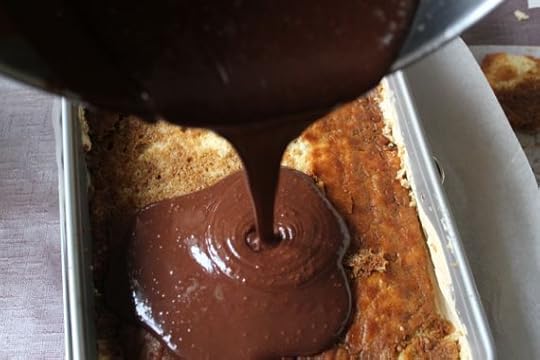 Til it hides the defects.
Til it hides the defects.
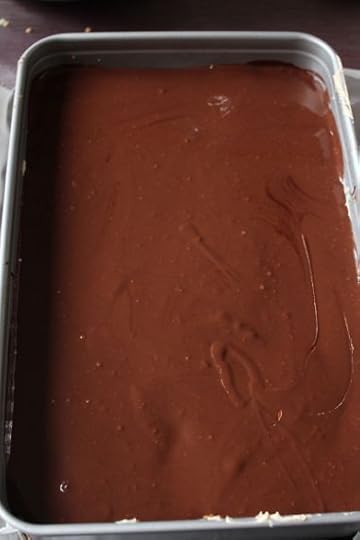 Place the third piece of cake (and brush/soak with coffee).
Place the third piece of cake (and brush/soak with coffee).
 And add the rest of your coffee buttercream.
And add the rest of your coffee buttercream.
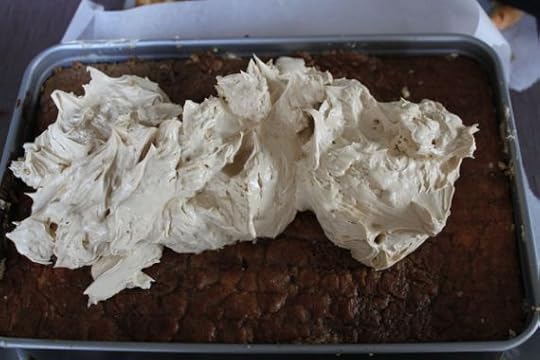 Seriously. Is this not a work of art?
Seriously. Is this not a work of art?
 Into the refrigerator for at least an hour.
Into the refrigerator for at least an hour.
Aaand . . . here’s where it all starts to fall apart.
 I had no idea the buttercream would get so hard. (Duh - right? It’s butter!) Make sure you dip a knife in hot water and separate the buttercream before removing the sides to the cake pan, if you happen to be using one like I did.
I had no idea the buttercream would get so hard. (Duh - right? It’s butter!) Make sure you dip a knife in hot water and separate the buttercream before removing the sides to the cake pan, if you happen to be using one like I did.
 But chocolate covers over a multitude of broken buttercream layers.
But chocolate covers over a multitude of broken buttercream layers.
 Especially when it’s as thick as cement. (Ahem).
Especially when it’s as thick as cement. (Ahem).
In the end it doesn’t matter. Everyone agreed that it tasted ah-MAZ-ing, no matter how it looked.
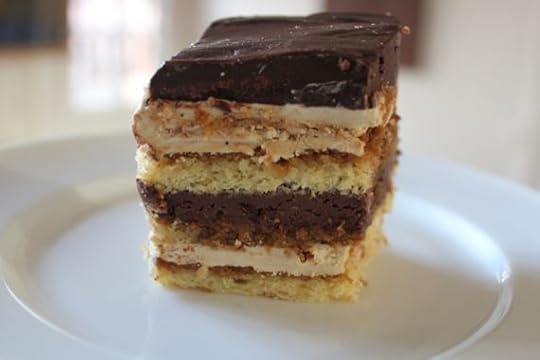 And if you have the patience for it, you too can wow your friends with a little French opéra. And it will be even more gorgeous than mine. I just know it.
And if you have the patience for it, you too can wow your friends with a little French opéra. And it will be even more gorgeous than mine. I just know it.

L’opéra
Prep time
14 hours
Cook time
2 hours
Total time
16 hours
A multi-layered cake with chocolate, espresso and buttercream.
From: Lady Jennie
Recipe type: Dessert
Cuisine: French
Serves: 16
Ingredients
Cake for pan 40×30 cm:
1 cup of eggs (220 g)
5 large egg yolks (80 g)
2.5 cups ground almonds (220 g)
1 cup – (minus) 1 Tablespoon sugar (175 g)
3 large egg whites (125 g)
½ c sugar to mix with egg whites (100 g)
1 cup flour (100 g)
Coffee Syrup:
1¾ cups filtered coffee (400 ml)
¾ cup sugar (150 g)
3 Tablespoons instant coffee (10 g)
Italian Merengue for the Buttercream:
3 T water (40 g)
½ cup sugar (100 g)
2 large egg whites (70 g)
¼ cup sugar to mix with egg whites (35 g)
Buttercream:
5 large egg yolks
1 cup + 1 T sugar (200 g)
½ cup – (minus) 1 T water (100 g)
2 cups butter (450 g or 4 sticks)
The Italian Merengue needs to go in, of course
½ espresso (mini cup)
3 T instant coffee, finely ground (10 g)
Chocolate Ganache:
170 grams dark chocolate
½ cup milk (120 g)
⅓ cup cream (40 g)
1.5 T butter (20 g)
Chocolate Glaze:
400 g dark chocolate 52%
3.5 T margarine (50 g)
4 T peanut oil (50 g)
Instructions
Step One: The cake
Preheat the oven to 200°C (400°F) and line 3 baking sheets with wax paper.
Mix the eggs (1 cup), sugar, egg yolks and almond powder for 15 minutes.
Beat the egg whites with the smaller amount of sugar listed, then combine the two.
Add the flour and stir well, but not with an electric mixer.
Spread an equal amount of batter on all three baking sheets and bake for 10-12 minutes each. Be careful though – my oven is hot so I needed to reduce the temperature and bake them for less time.
After they cool, put them in the fridge with wax paper in between and cover them with saran wrap overnight.
Take out the 2 cups of butter and let it sit out overnight.
Step Two: The Italian Mrengue
Heat the water and sugar until it reaches 114°C.
At that point start mixing the egg whites and sugar until stiff.
When the water/sugar mix reaches 118°C exactly, take it off the heat and pour it slowly into the egg whites while they are mixing.
Set aside.
Step Three: The Coffee Buttercream
Do the same thing with the larger amount of water and sugar – cook it until 118°C.
Beat the egg yolks and add the sugar mix slowly until incorporated, and until the yolks start to form ribbons.
On the side, beat the softened butter, and then add that to the yolks.
Add the merengue and beat that in.
Finally, add the coffee and beat that. It’s done.
Step Four: The Ganache
Chop up the chocolate.
Heat the milk and cream.
When the milk is hot, pour it over the chocolate and stir it until it all melts.
Add the butter and mix it. The ganache is done.
Step Five: Make the coffee syrup for the cakes.
Take the filtered coffee, and add the sugar and instant powder.
Put that aside with the pastry brush and get ready to soak the cakes.
Step Six: The Assembly.
Place a piece of wax paper on the baking sheet, followed by the first cake layer.
Brush a third of the coffee syrup on it until it’s soaked and brown.
Put half of the coffee buttercream.
Put another cake layer and soak with another third of coffee syrup.
Pour all of the ganache on top of that.
Put the third cake layer and soak with the remainder of the syrup.
Top that with the rest of the buttercream.
Put it in the refrigerator for at least an hour.
Step Seven: The chocolate glaze and finishing touch
Heat, but don’t overheat the chocolate, oil and margarine. It should be quite runny.
Take your opéra out of the fridge, and if you’ve used a pan with sides, separate the hardened buttercream from the side of the pan with a hot knife.
Pour the glaze over the top of the opera and use a metal spatula to smooth it over.
Step Eight: Serving the opéra
Keep your opéra in the refrigerator for the entire day, but take it out about an hour before you wish to serve. This will help the buttercream to soften and make the whole thing easier to cut. You can cut small pieces because it’s quite rich.
And you might possibly wish to skip serving coffee with it if you ever hope to get any sleep.
3.2.1263
The post Step-by-Step Instructions for Making an Opéra appeared first on A Lady In France.
December 8, 2013
How to Pray
There is no formula for prayer. When Gabriel was 2 1/2 and still wearing diapers, he wandered off from our house in the country to see the cows. By the time we realised he was gone, he was nowhere to be seen. I looked all over the house and the yard, and when I didn’t see him there, I ran over to the busy street and started to walk alongside of it in search of him. But when I didn’t see him right away, my steps faltered. I couldn’t continue to go down that busy street because I dreaded what I might find.
My husband thought of the cows and ran down the other lane – the quieter one – and when he finally got to the bend in the road, and looked off in the distance, he saw a tiny figure, crying, and walking in the middle of the road. He yelled, “I found him!” and word spread to our neighbours and to my own ears. I put my hands on my knees and trembled in relief.
Throughout that entire time, I was only able to utter a terrified, “God, God, God, God, God, God.” I was not able to formulate a single word other than “God” in prayer.
In the same way the Spirit also comes to help us, weak as we are. For we do not know how we ought to pray; the Spirit himself pleads with God for us in groans that words cannot express. (Romans 8:26)
God doesn’t need us to say set formulas in order to hear us. But Jesus did revolutionise prayer for us by teaching us that we could approach God as a Father. He told us how to pray, by saying, “This, then, is how you should pray:
“‘Our Father in heaven,
hallowed be your name,
your kingdom come,
your will be done,
on earth as it is in heaven.
Give us today our daily bread.
And forgive us our debts,
as we also have forgiven our debtors.
And lead us not into temptation,
but deliver us from the evil one.” (Matthew 6:9-13)
It doesn’t mean that he gave us a new formula to say, but rather that when we pray, we should remember that God is not only our Father (and we can meditate on all the ways he showers us with love), but that he is also in heaven. And he deserves respect.
He went on to teach us that we should pray for God’s will to be done, for leaders to lead well, for people to be gracious and generous, for sin to be ousted so that we can have a little bit of heaven on earth.
He told us to pray for just what we need today. Do we have a stressful day? Pray for that. Are we getting medical results? Pray for that. Do we have an interview and desperately need a new job? Pray for that. Don’t worry about tomorrow. Pray for the needs today.
And ask God to forgive us, as we also forgive those who sin against us. And keep temptation and Satan far away. Jesus got right to the point. He prayed for the most basic things.
He then focused a little more on the forgiveness aspect, by adding (in vs 14&15):
For if you forgive other people when they sin against you, your heavenly Father will also forgive you. But if you do not forgive others their sins, your Father will not forgive your sins.
We can’t expect God to forgive our sins and hear our prayers if we have a chokehold of anger on our brother or sister (or neighbour, friend or boss). Sometimes part of our prayer will include, “God I do forgive so & so; help me to overcome the feelings I have against them that make it feel like I have not forgiven.”
So those are the basics right there. But there are some notable prayers in the Bible, and some other aspects that might encourage you in your prayer life.
I. It’s okay to bargain:
Take a look at what Abraham did on behalf of the cities of Sodom and Gomorrah (where his nephew Lot was living). He negotiated with God 7 times to get him to change his mind. Seven times! That’s some pretty bold prayer.
Then the Lord said, “The outcry against Sodom and Gomorrah is so great and their sin so grievous that I will go down and see if what they have done is as bad as the outcry that has reached me. If not, I will know.”
The men turned away and went toward Sodom, but Abraham remained standing before the Lord. Then Abraham approached him and said: “Will you sweep away the righteous with the wicked? What if there are fifty righteous people in the city? Will you really sweep it away and not spare the place for the sake of the fifty righteous people in it? Far be it from you to do such a thing—to kill the righteous with the wicked, treating the righteous and the wicked alike. Far be it from you! Will not the Judge of all the earth do right?”
The Lord said, “If I find fifty righteous people in the city of Sodom, I will spare the whole place for their sake.”
Then Abraham spoke up again: “Now that I have been so bold as to speak to the Lord, though I am nothing but dust and ashes, what if the number of the righteous is five less than fifty? Will you destroy the whole city for lack of five people?”
“If I find forty-five there,” he said, “I will not destroy it.”
And . . . Abraham got the number down to ten.
“When the Lord had finished speaking with Abraham, he left, and Abraham returned home. (Genesis 18:20-33)
Or take a look a look at this unusual dialogue in the New Testament. In Matthew 15:22-28
A Canaanite woman from that vicinity came to him, crying out, “Lord, Son of David, have mercy on me! My daughter is demon-possessed and suffering terribly.”
Jesus did not answer a word. So his disciples came to him and urged him, “Send her away, for she keeps crying out after us.”
He answered, “I was sent only to the lost sheep of Israel.”
The woman came and knelt before him. “Lord, help me!” she said.
He replied, “It is not right to take the children’s bread and toss it to the dogs.”
“Yes it is, Lord,” she said. “Even the dogs eat the crumbs that fall from their master’s table.”
Then Jesus said to her, “Woman, you have great faith! Your request is granted.” And her daughter was healed at that moment.
I can’t claim to understand why Jesus would say such a seemingly heartless thing to a woman who was begging him for help. Maybe he was keeping his focus narrow, knowing that the time would come after his death when God’s mercy would extend to all nations. I don’t know. But she didn’t give up. She talked back to Jesus! She insisted.
And he loved it. Yes, we need to honour God; yes, we need to give him the glory he deserves. But he wants us to be comfortable and familiar too. He wants us to urge a little bit, to argue our point of view. Because that means we have faith.
Prayers should be brief:
And when you pray, do not keep on babbling like pagans, for they think they will be heard because of their many words. Do not be like them, for your Father knows what you need before you ask him. (Matthew 6:7-8)
I’ve heard people pray something like, “God. Yes, God. Mercy God. Please, Mercy, mercy, mercy. God, God, Holy God. Mercy God.” And it goes on and on. It’s great to have the heart to address God, but he gave us the ability to construct a sentence, and he wants us to use it in prayer.
And then there’s also Ecclesiastes 5:2, which is pretty convicting.
Do not be quick with your mouth,
do not be hasty in your heart
to utter anything before God.
God is in heaven
and you are on earth,
so let your words be few.
(cough, cough). This gets me every time. I’m pretty careful when I pray not to deceive myself. I don’t try to look good in front of God since he can see right through me anyway. I’m careful with the words I utter in prayer.
We need to be surrendered. Here’s a mini story from one of the heroes in the Bible – David. Instead of leading his troops to war, like he was supposed to, he stayed home and slept with someone’s wife. When he got her pregnant, he put her husband in the heaviest part of the battle so he would be sure to be killed, and never find out that David had taken his wife. Nathan, the prophet, had something to say about what he had done and gave him a sharp rebuke. David’s response?
Then David said to Nathan, “I have sinned against the Lord.”
Nathan replied, “The Lord has taken away your sin. You are not going to die. But because by doing this you have shown utter contempt for the Lord, the son born to you will die.” (Note – there is plenty of evidence that God does not take away our loved ones in punishment for our sins, so please don’t apply this exception to your own life).
After Nathan had gone home, the Lord struck the child that Uriah’s wife had borne to David, and he became ill. David pleaded with God for the child. He fasted and spent the nights lying in sackcloth on the ground. The elders of his household stood beside him to get him up from the ground, but he refused, and he would not eat any food with them.
On the seventh day the child died. David’s attendants were afraid to tell him that the child was dead, for they thought, “While the child was still living, he wouldn’t listen to us when we spoke to him. How can we now tell him the child is dead? He may do something desperate.”
David noticed that his attendants were whispering among themselves, and he realized the child was dead. “Is the child dead?” he asked.
“Yes,” they replied, “he is dead.”
Then David got up from the ground. After he had washed, put on lotions and changed his clothes, he went into the house of the Lord and worshiped. Then he went to his own house, and at his request they served him food, and he ate.
His attendants asked him, “Why are you acting this way? While the child was alive, you fasted and wept, but now that the child is dead, you get up and eat!”
He answered, “While the child was still alive, I fasted and wept. I thought, ‘Who knows?The Lord may be gracious to me and let the child live.’ But now that he is dead, why should I go on fasting? Can I bring him back again? I will go to him, but he will not return to me.” (2 Samuel 12:13-23)
While there was still hope, David did what he could. He fasted and prayed. But as soon as he saw that God had made his decision, he got up and continued living. That shows great humility. That is one of the reasons God called David, “a man after my own heart.”
 We’re almost done. I’m sorry I can’t seem to make my faith posts any shorter. The other thing we should be in prayer is persistent:
We’re almost done. I’m sorry I can’t seem to make my faith posts any shorter. The other thing we should be in prayer is persistent:
Then Jesus told his disciples a parable to show them that they should always pray and not give up. He said: “In a certain town there was a judge who neither feared God nor cared what people thought. And there was a widow in that town who kept coming to him with the plea, ‘Grant me justice against my adversary.’
“For some time he refused. But finally he said to himself, ‘Even though I don’t fear God or care what people think, yet because this widow keeps bothering me, I will see that she gets justice, so that she won’t eventually come and attack me!’”
And the Lord said, “Listen to what the unjust judge says. And will not God bring about justice for his chosen ones, who cry out to him day and night? Will he keep putting them off? (Luke 18-1:7)
Don’t give up. Keep praying. If someone on earth who doesn’t care about God or people will give in just so someone stops pestering them, how much more will God give in to those he loves? (Although – keep in mind persistence and surrendered are two sides to the balance).
Jesus finished by saying,
I tell you, he will see that they get justice, and quickly. However, when the Son of Man comes, will he find faith on the earth?” This gets me every time. It sounds so plaintive and sad – almost like Jesus is worried that there will be no more faith on earth by the time he comes back.
I know it’s not so – Jesus is optimistic, and faithful, and strong. But it makes me determined that I – at least – will be one person he finds on earth who will still have faith.
What are your essentials in prayer?
(Image credit: daynamore / 123RF Banque d’images)
The post How to Pray appeared first on A Lady In France.
December 6, 2013
Back to our Regularly Scheduled Program
Hi folks! So I think I’m done with the hardest part on my book – the edits! And it will be out soon. (I’ll keep you posted). That means I can get back to “normal life” if there is such a thing. And of course the holidays are coming up, which is anything but normal. However, I can get back to regular posting on each of the categories and hopefully catch up with some of your lives as well! (Yay!)
I started my newly-found free time by cleaning the house. It may or may not have required a bulldozer.
 And tonight we have our usual Bible Discussion, except we’re going to trim the tree instead of having a discussion!
And tonight we have our usual Bible Discussion, except we’re going to trim the tree instead of having a discussion!
 The kids are so excited.
The kids are so excited.
 Little do they know that I have put out (for the first time ever) (drum roll . . .) their pewter stocking holders!
Little do they know that I have put out (for the first time ever) (drum roll . . .) their pewter stocking holders!
 My sister brought them over from the States last year.
My sister brought them over from the States last year.
 They look so adorable.
They look so adorable.
 I was totally bummed that the stockings I had bought for the first two children were no longer available by the time William came around. Actually, they were on sale two weeks before he was born so I knew they were on there way out, but I didn’t want to get it monogrammed until the baby was born, and by the time I was ready to purchase one, they were gone.
I was totally bummed that the stockings I had bought for the first two children were no longer available by the time William came around. Actually, they were on sale two weeks before he was born so I knew they were on there way out, but I didn’t want to get it monogrammed until the baby was born, and by the time I was ready to purchase one, they were gone.
This week we’ve taken time off to spend as a family. There are still the English classes in the morning, and the soccer match, trumpet lesson and dance class in the afternoon. But we’re going to introduce our kids to “It’s a Wonderful Life” at the end of the day by watching it together. I’m making popcorn!
And then Sunday after church we’ll head over to the Petit Palais on the Champs Elysées, and visit the Christmas market while we’re at it. (I’ll take pictures for you).
It’ll be fun. Otherwise, I’m making headway with the Christmas shopping and just have to get a few Christmas cards out. And. . . I also have to learn the alto aria #6 in Handel’s Messiah because I’ve been asked to sing it for our Christmas service on Dec 22.
Have I mentioned I’m not a trained singer? gulp.
I bought the extended work so I could learn it by listening along as I read the music. We only had excerpts of the Messiah and it did not include this obscure air.
Does any of this singing talk mean anything to any of you, apart from Korinthia who makes violins? Isn’t that cool, by the way? Do you know anyone who makes instruments?
Let me wind up this little hodgepodge of a post by saying something a little more serious: Goodbye to Nelson Mandela, who died yesterday. And thank you for your heart and your service.
 See you all Monday!
See you all Monday!
The post Back to our Regularly Scheduled Program appeared first on A Lady In France.



